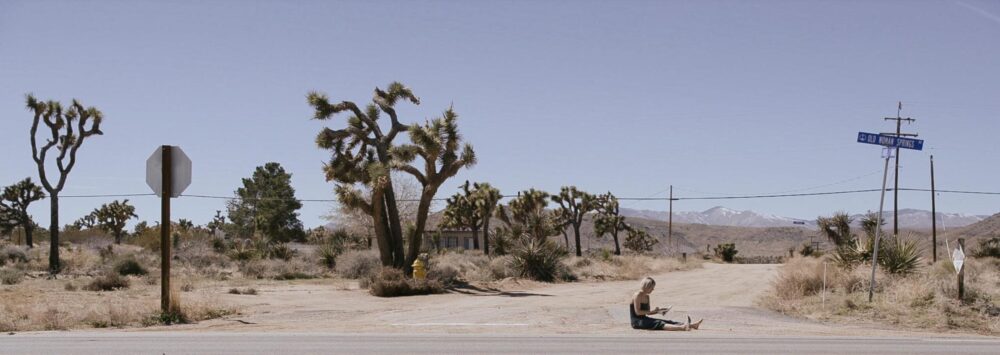Road movies that serve as narrative device for the lead characters’ development are a dime a dozen. Independent films, in particular, have the penchant for those road scenes featuring either lush landscapes or dusty highways and backroads. “Roving Woman” shouldn’t be any different. After all, Chloé Zhao already perfected the formula with her critically acclaimed “Nomadland.”
However, first-time director Michal Chmielewski has a familiar face as the film’s executive producer: Wim Wenders himself, master of desolate imagery that aptly embodies slow cinema. And with a meandering pace allowing for deeper introspection, “Roving Woman” manages to resonate as a film of reflection and self-discovery.
Chmielewski and co-writer Lena Gora (who stars as Sara, the titular ‘roving woman’) raise the stakes from the get-go: the movie begins with a dumping. While initially it didn’t deter Sara—she spent the whole night on her ex’s doorstep dressed in an evening gown—realization kicked in the next morning when she finds that it’s really over. Without any way of getting back into the house to get her stuff, she wanders around the neighborhood before hitching a ride in the car of his ex’s friend Brian. Once she gets well out of town, Sara continues on her own, without any money, food, and clothes.
Seeing an unattended car nearby, however, her compulsion takes over and steals it (Robbie Basho’s “Blue Crystal Fire” playing in the background as this scene plays out is a terrific stylistic touch). As she takes on a directionless road trip, Sara’s journey would be greatly defined not only by the motley crew of people that she’d meet along the way; but also the owner of the stolen car, whose personal effects pique Sara’s genuine interest.

A ‘Roving Woman’ Out to Find Herself
As for the reason Sara ended up sleeping on her ex’s doorstep and eventually driving along the long, dusty, desert roads, the film never contextualizes. In fact, the filmmakers seem to believe that the focus shouldn’t be on the breakup, but instead on the actions Sara undertakes as a result. Talking to herself while driving, she imagines a conversation she might have had with her ex. She counters that the breakup was her idea, a decision that would allow her to find herself. Are the childlike acts of impulse—stealing a car, sneaking into a closed pool to swim naked—her coping mechanism? Or are they simply expressions of liberation?
At the same time Chmielewski invites the viewers to examine Sara’s psyche (given the lack of context); the protagonist finds herself getting more interested in the owner of the car she stole. In particular, a compact disc labeled “for Mimi” contains songs written by a man who’s likely the owner of the car. He also speaks in between songs, as though the whole CD were a diary he used to recount his every day to a certain ‘Mimi’.
In large part due to that CD, it doesn’t take long for Sara to fall in love with the car’s owner and decide to find him. Along the way, however, she spends a lot of time to reflect on what went wrong; all the while following said impulses and meeting a host of quirky characters whose varying outlooks in life would give Sara additional perspectives she didn’t have before.
Of Introspective Road Trips Leading to both Nowhere and Everywhere
The movie contains a scene where Sara listens to the radio and the DJ introduces the next song. The song in question was of Connie Converse; a singer-songwriter who mysteriously disappeared in 1974 when she left her family home in search of a new life and was not heard from again. This reference parallels what Sara intends to do now that there’s exhilaration in liberation. However, it seems like Sara wasn’t in search of a new life the same way Converse was. I’d like to think that, on the contrary, she still hasn’t found her current one.
Whatever the case, director Chmielewski’s ability to channel Wenders’ aesthetic filmmaking deserves praise here. “Roving Woman” busies itself with beige tones, tall Joshua trees and cacti that look like they’ve seen a thousand lifetimes, and cinematography so immersive you can almost feel the onscreen heat scorch your skin. These imageries create a perfect backdrop as Sara continues on with her journey. And when she finally encounters the owner of the car (John Hawkes in a short but powerful role); Sara realizes that what was once an aimless wandering might be worth all the trouble in the world.
A Film that Fortunately Arrives to its Rightful Destination: Connecting with Audiences
“Roving Woman” is as every bit Sara’s story as it is of the strangers whom she meets along the way. The thing that sticks out in this film is that kindness still exists in the world; and that’s exactly what Michal Chmielewski aims to show. Sure, the movie could lag at times and the dialogue might sound a little forced; but the nuances of the performances offset those minor quibbles. The existential musings sometimes border on overt melancholy, yes; but they thankfully never overstay their welcome. And for a first-time director in Chmielewski, that’s an achievement in itself.
On road-trip movies that put premium more on the journey and less on the destination; “Roving Woman” makes it clear that there are no endpoints. Heck, for what it’s worth, even Sara herself doesn’t know where she’s going. Ultimately, the film invites the audiences to embark with its protagonist on a slow-burning trip underscored by her reflection and eventual self-discovery.
At any rate, whereas there might not even be a journey for her to begin with, Sara might have just found a place in the end where she was always meant to be.
Support the Site: Consider becoming a sponsor to unlock exclusive, member-only content and help support The Movie Buff!